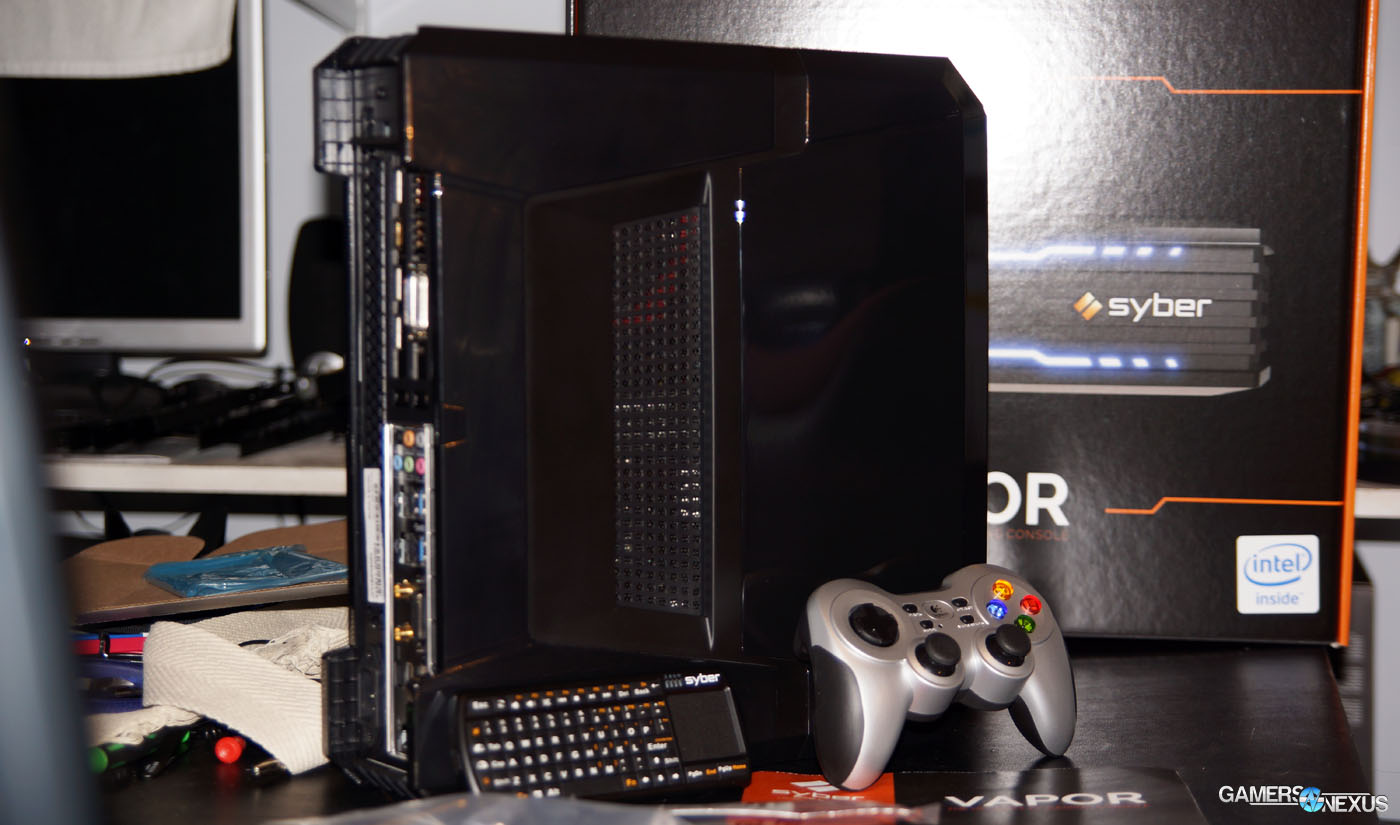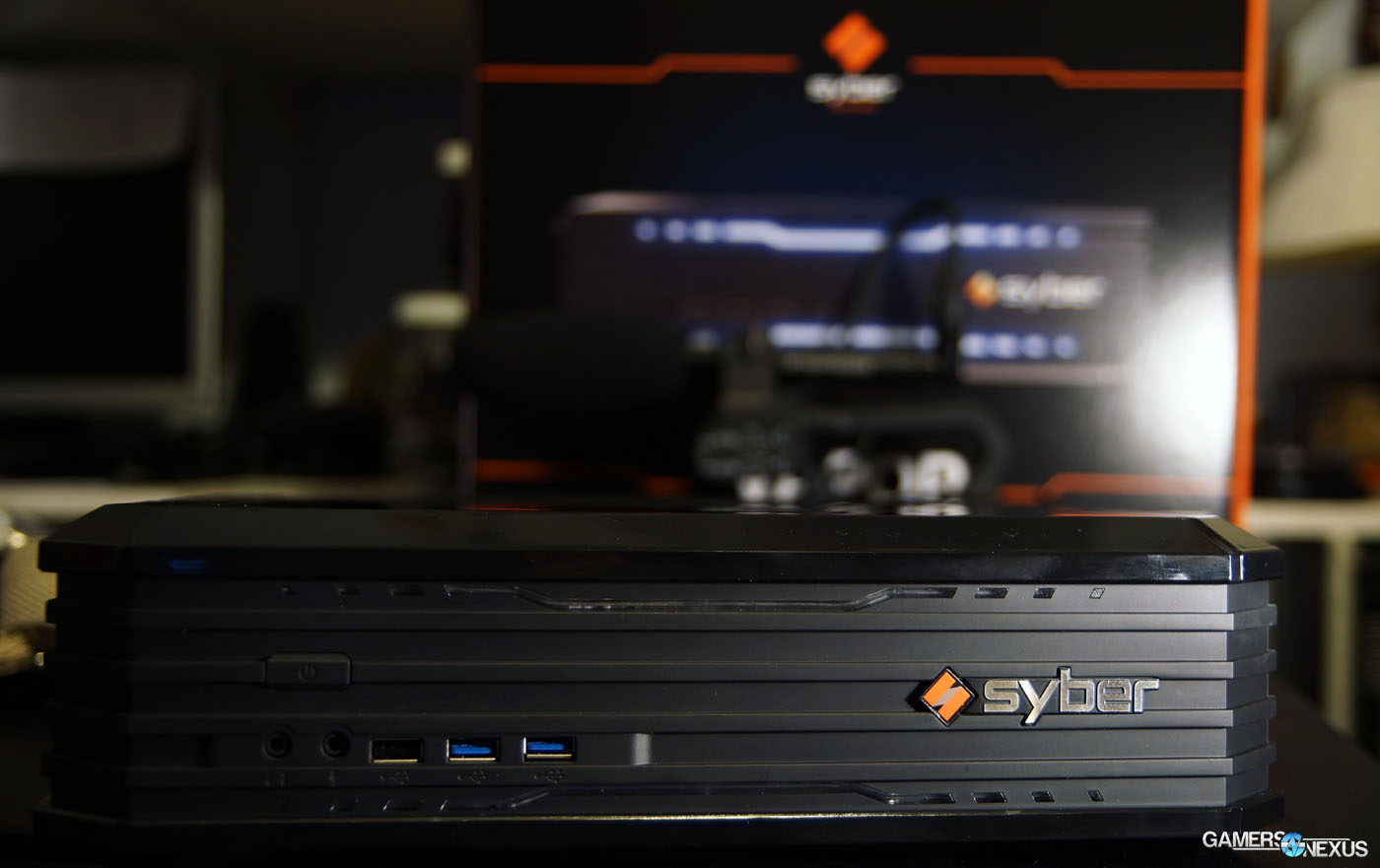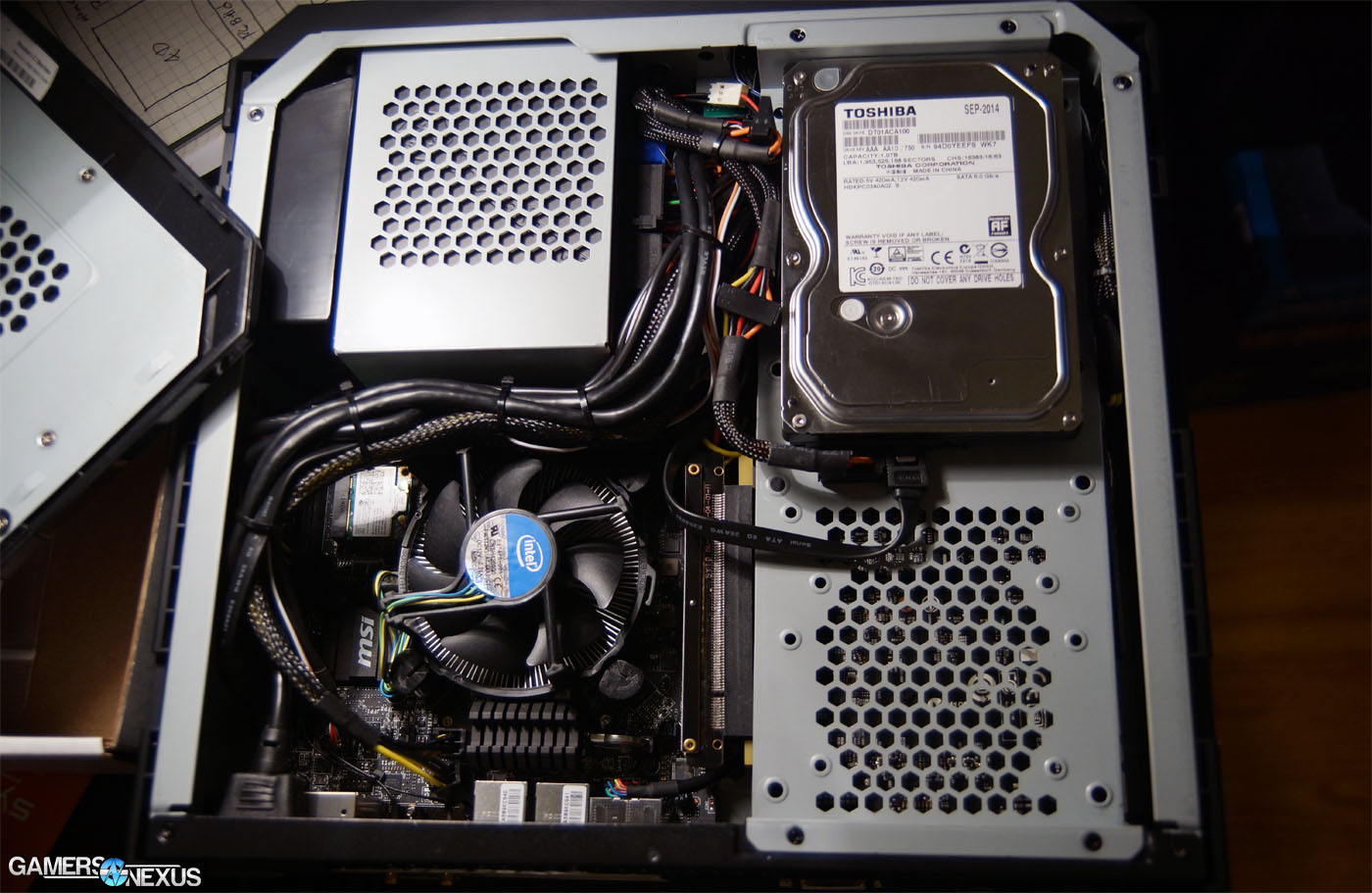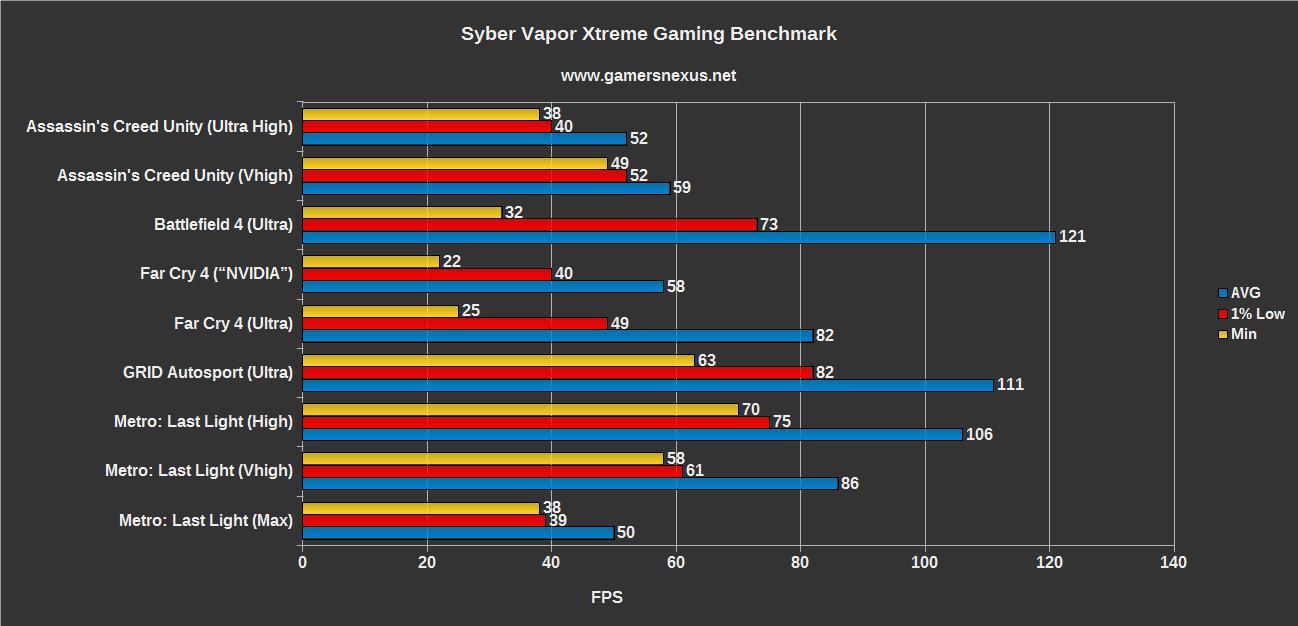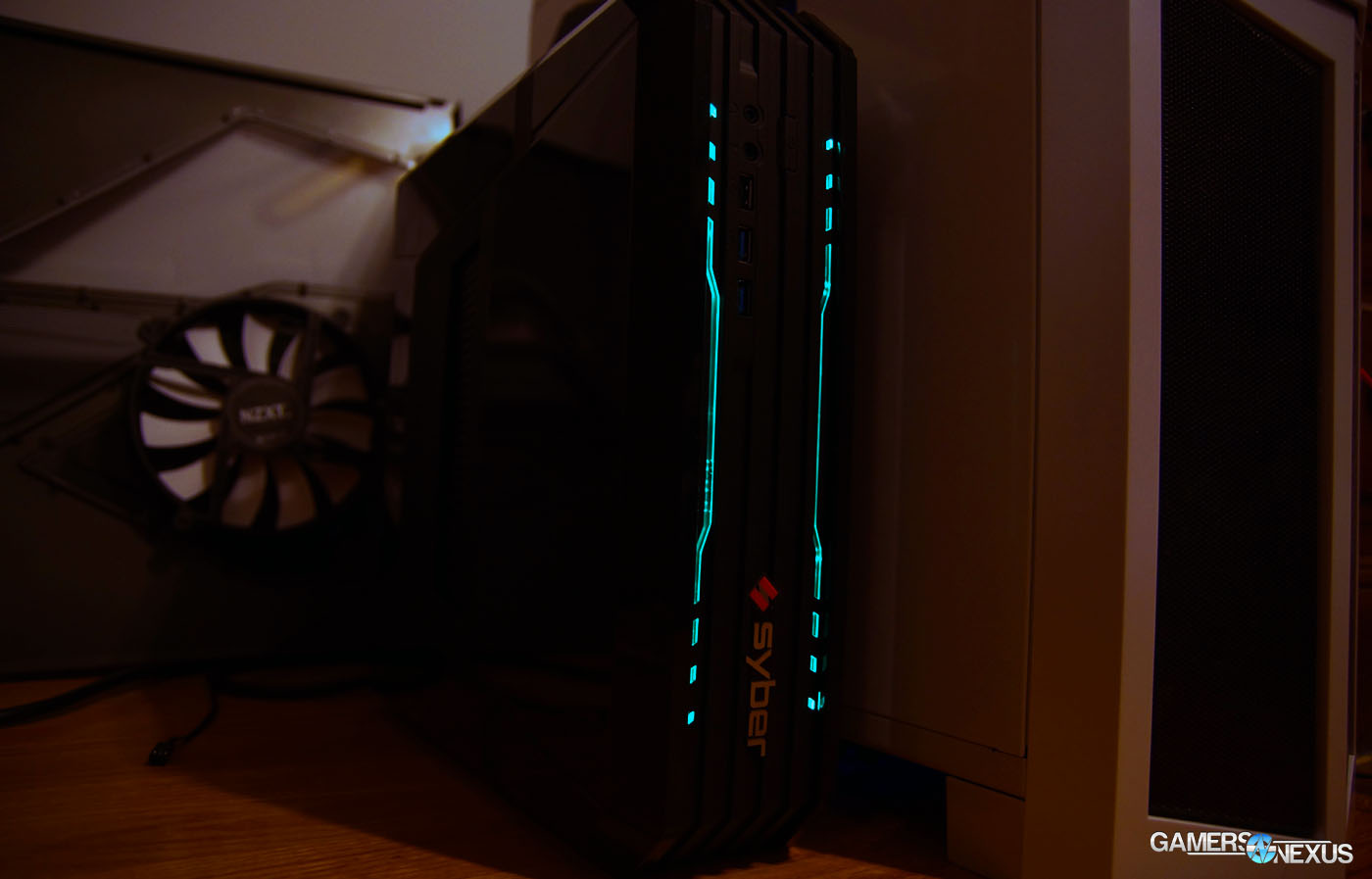The advent of affordable, low TDP, high-performance PC hardware has enabled configuration of living room gaming PCs that act as consoles once did. The difference, of course, is more versatile functionality and greater immediate upgrade potential, ensuring gaming at the highest settings possible while retaining DVR-replacement options. There's no argument that traditional gaming consoles – like the Xbox and PS4 – have their place in this industry, but diehard PC enthusiasts finally have affordable Small Form Factor (SFF) HTPC configurations.
We recently explored the possibility of a $665 DIY HTPC with moderate graphics performance, effectively serving as a budget console replacement with Netflix / streaming options. The entire system measured in at just 20.9” x 10.2” x 14.5” – easily hidden beneath the TV.
Today's review looks at a significantly more powerful option, featuring the GTX 980 (which we've called “the best video card available”) and an i7-4790K CPU. The “Vapor Xtreme” is CyberPower's latest venture, branded independently as a “Syber” PC, similar to Kingston's branding separation with its HyperX division.
CyberPower is a long-time system integrator, one of the many companies responsible for BTO (built-to-order) gaming PCs. CyberPower generally competes with iBUYPOWER, Digital Storm, Origin, and similar SIs. The group spun-off its new “Syber” brand earlier this year, explicitly targeting the living room and more mainstream market segments. Somewhat shockingly, we found the Syber Vapor Xtreme to be highly affordable when compared to the DIY alternative using identical parts – a bit of a rarity among SIs in years past.
System Integrators have a mixed reputation among the PC building community. Even today, it's common to see high-end pre-built systems with awkward parts selections – often forced by MDF – or significantly worse purchasing value against a DIY alternative. When we spec'd out the Vapor Xtreme “by hand,” as you'll see in the table below, the cost was just $100 more than the identically-specified DIY alternative. It's easy to scoff at a pre-built, but the fact of the matter is that not everyone has the time, capacity, confidence, or ability to build their own computer. The enthusiast crowd enjoys PC building, but sometimes it's nice to have peace-of-mind that a system will be supported when things go wrong. Not everyone wants what the majority of our readers seek in the DIY process – keep this in mind for the Syber review.
Regardless, a pre-built system isn't for everyone, so we'll be reviewing the Vapor Xtreme from the standpoint of those who'd rather buy something pre-assembled. At +$100 over base DIY cost, the price is good – we've just got to see if the performance matches and the parts selection is logical.
This review determines whether the $1500 Syber Vapor Xtreme is “worth it,” providing framerate performance benchmarks on various titles (ACU, Far Cry 4, Battlefield) and thermal analysis.
Syber Vapor Xtreme Hands-On: Build Quality, FPS, & Small Form Factor
Syber Vapor Lineup Specifications: Vapor A, I, & Xtreme
| Syber Vapor Xtreme | Syber Vapor I | Syber Vapor A | |
| Price | $1500 | $700 | $600 |
| CPU | Intel® Core i7 4.0 GHz | Intel® Core i3 3.5 Ghz | AMD Athlon X4 840 3.1 GHz |
| CPU Type | LGA 1150 | LGA 1150 | FM2+ |
| Motherboard | Intel Z97 Chipset | Intel H81 Chipset | AMD A78 Chipset |
| Storage | 1TB SATA III HDD | 1TB SATA III HDD | 500GB SATA III HDD |
| Memory | 8GB DDR3 1600 MHz | 8GB DDR3 1600 MHz | 4GB DDR3 1600 MHz |
| GPU | Nvidia GTX 980 4GB DDR5 | NVIDIA GeForce GTX 750Ti 2GB GDDR5 | AMD Radeon R9 270 2GB GDDR5 |
| Controller | Logitech F710 Wireless Controller | Logitech F710 Wireless Controller | Logitech F710 Wireless Controller |
| Controller Specs | 2 Analog Sticks 2 Analog Triggers 12 Digital Buttons | 2 Analog Sticks 2 Analog Triggers 12 Digital Buttons | 2 Analog Sticks 2 Analog Triggers 12 Digital Buttons |
| Keyboard | Mini QWERTY Keyboard + Touch Pad | Mini QWERTY Keyboard + Touch Pad | Mini QWERTY Keyboard + Touch Pad |
| Front I/O Ports | 1X USB 3.0 2X USB 2.0 Audio, Mic | 2X USB 2.0 Audio, Mic | 1X USB 3.0 2X USB 2.0 Audio, Mic |
| Rear I/O Ports | 2X USB 3.0 2X USB 2.0 | 2X USB 3.0 4X USB 2.0 | 2X USB 3.0 4X USB 2.0 |
| Display Output | HDMI 4.1 DVI-D Port | HDMI 4.1 DVI-D Port | HDMI 4.1 DVI-D Port |
| Audio Output | Headphone/Audio Out SPDIF HD Audio | Headphone/Audio Out SPDIF HD Audio | Headphone/Audio Out SPDIF HD Audio |
| WiFi | 802.11ac/g/n | 802.11ac/g/n | 802.11ac/g/n |
| Bluetooth | N/A | N/A | 4.0 |
| Lan Networking | 10/100/1000GB RJ-45 | 10/100/1000GB RJ-45 | 10/100/1000GB RJ-45 |
| Power | 450 Watts Power Supply | 250 Watts Power Supply | 250 Watts Power Supply |
| Operating System | Windows 8.1 | Windows 8.1 | Windows 8.1 |
| Installed Software | Valve Steam Client | Valve Steam Client | Valve Steam Client |
| Dimensions | 351mm x 345mm x 98.5mm (W x D x H) | 351mm x 345mm x 98.5mm (W x D x H) | 351mm x 345mm x 98.5mm (W x D x H) |
| Weight | 36 lbs | 36 lbs | 36 lbs |
CyberPower Syber Vapor PC vs. Do It Yourself PC Build Pricing
| Identical DIY Approach | Syber Vapor Xtreme | |
| CPU | i7-4790K 4.0GHz ($315) | i7-4790K 4.0GHz |
| Motherboard | MSI Z97I MITX AC ($140) | MSI Z97I MITX AC |
| GPU | NVIDIA GTX 980 4GB ($560) | NVIDIA GTX 980 4GB |
| RAM | 2x4GB DDR3 1600MHz ADATA XPG V1.0 ($65) | 2x4GB DDR3 1600MHz ADATA Value RAM |
| Storage | 1TB WD 7200RPM HDD ($50) | 1TB Toshiba 7200RPM HDD |
| PSU | SilverStone SFX450 80+ Gold ($91) | SilverStone SFX450 80+ Gold |
| Case | Azza Mini Z ITX Case ($45) | Custom enclosure |
| Controller | Logitech F710 ($50) | Logitech F710 |
| OS | Windows 8.1 (must download - $100) | |
| Price | $1416 | $1500 |
Syber's new Vapor Xtreme “PC Console” is marketed as a living room console replacement, ultimately serving as an HTPC streaming device with high-end gaming capabilities. And they are high-end: The Syber Vapor Xtreme is equipped with a GTX 980 video card and i7-4790K CPU, making it one of the highest-end single GPU configurations available without venturing into X99 territory. Our review unit included 2x4GB of ADATA value memory clocked at 1600MHz, though we would have liked to see heatsink-equipped RAM used instead. Beyond this, a single 7200RPM HDD is present, offering 1TB of total storage. SSDs are available only as a customer-specified option and are not included in the reference models.
Our machine uses an MSI Z97I mini-ITX motherboard, which hosts on-board AC wireless and Bluetooth 4.0 compatibility – both ideal in a living room use case scenario. Bluetooth offers added functionality should the user decide to utilize one of the many remote control applications, eliminating the need for another inevitably lost remote.
Speaking of lost remotes, CyberPower's lost me a bit on the inclusion of their “mini remote” touchpad-enabled keyboard. The included keyboard is a bit longer than a phone and uses physical input adjacent to a laptop touchpad. Although the gesture is appreciated, the keyboard is largely unusable and frustrating due to its impossibly small size – we'd have preferred if the company furthered its Logitech partnership by including one of their proper wireless keyboards instead. Alternatively, including information on a phone application for remote control and typing would not go unappreciated.
What is appreciated, though, is the inclusion of Logitech's F710 wireless gamepad, a fierce alternative to the high-quality Xbox 360 wireless controller. We've tested the F710 extensively (and against the 360 controller) during this review process, and although it isn't the focus of the post, we can speak to its quality and performance in living room gaming.
We're generally happy with the selection of core components. The CPU and GPU match (granted, an i5-4690K would have been perfectly acceptable and cheaper), the motherboard is one that we would recommend in a similar build, and the 450W, 80 Plus Gold SilverStone SFX PSU is one that we've raved about in the past. Really, the PSU deserves most of the spotlight here: CyberPower gave us just enough power to run the 980 + 4790K efficiently, not over-supplying the system and sticking to high efficiency ratings (80 Plus Gold) for cheaper extended uptimes.
As Expected: A Few Odd Component Choices
Back to components: The motherboard selection is fitting of a high-end mini-ITX machine, the CPU selection makes sense when accompanied by a GTX 980 – though is potentially a bit unnecessary – and the GPU selection ensures high-end gaming performance. The Vapor Xtreme's enclosure is sized similarly to an Xbox (the original), but can be easily hidden away on a TV stand and makes for an aesthetically-fitting case.
We did find a few of the choices odd, though: The total oversight of an included SSD in the reference model seems wrong for a system operating on a joint ~$880 CPU + GPU budget, especially considering its target for home theater PC use. In all of our HTPC builds – including the one I use personally – we strongly recommend SSDs to minimize boot-up and wake times. Operating systems get bloated and slow as they age. An SSD makes all the difference in boot-up times, and although boot time may be less important for a desktop, HTPCs live and die on their ability to deliver content to the user on demand. Booting in 8 seconds can make the difference between booting to Netflix or groaning and walking away.
Speed is not the least of the advantages an SSD yields, either. Spinning platters make noise – sometimes a lot of it, depending on volume levels of other components and fans. Opting for an SSD for primary functions and an HDD for media storage (which spins-down when unused) would be preferable for noise levels. In our review of HTPC components and systems, we hold noise levels to a higher standard due to the nature of their operating environment; no one wants fan noise constantly humming in their living room.
That said, hard drive noise ends up being unnoticeable underneath the noise of Intel's stock cooler. The Vapor Xtreme can run relatively loud when operating under load due to its struggle to intake cool air. All air intake is limited to the GPU fan, CPU fan, and PSU fan, each accessing the outside world through ventilated paneling.
All this said, the other components make sense and we're thrilled about the PSU selection. It's good to see high-quality power supplies getting use in SI builds.
Resolved with User Upgrades
CyberPower would undoubtedly challenge these complaints with the fact that the box is easily upgradeable – and they'd be right to do so. You could grab a 256GB SSD for $115 and a low-profile air cooler for $32. At this point, we haven't increased cost significantly over a DIY option that'd add similar components. Upgrading RAM begins to feel more questionable in value. Given the heat output of the system and limited cooling, heatsinks would not go amiss on the RAM, though you'd still need a means through which that heat is dissipated – the adjacent aftermarket CPU cooler would help.
All Said, The Vapor is Still High Build Quality
Despite my component selection complaints – some of which are resolved if building-to-order or upgrading – Syber's Vapor Xtreme is still a solid system on paper. The motherboard and PSU used are quality, unlike some other SI options, and the CPU / GPU combination makes more sense than a lot of other pre-builts. The whole assembly feels largely “natural,” like components we'd piece together (more or less) if left to our own devices.
The Syber Vapor Xtreme is a tiny, powerful, high-performance HTPC that is dying to be a “Steam Box” (it even boots to Big Picture mode on first launch), priced at $100 more than a DIY build. The system ships with no bloatware beyond the usual motherboard control panel software, giving reprieve to those of us who survived the earlier days of pre-built systems from mainstream manufacturers. A DIY approach would potentially allow for better cooling, but then you're building in a larger case. Syber's stock enclosure hosts zero case fans, but saves on space in doing so. It's a trade-off, as is anything in the small form factor market. Case fans would be less necessary if upgrading the CPU cooler to a non-stock solution.
Continue to the next page for the benchmark results & conclusion.
Test Methodology
The above is a video overview of our Far Cry 4 benchmark course. Follow the same path to replicate our tests. The video shows Far Cry 4 at max settings (Ultra / “NVIDIA”) with soft shadows, HBAO+, and TXAA 4x at nearly 60FPS / 1080p. We have similar courses for Assassin's Creed and other games.
We ran an identical 120-second circuit in all games for the tests.
For analysis of VRAM consumption, we logged GPU metrics using GPU-Z and analyzed them after the benchmarks. RAM consumption was analyzed with the native system resource monitor.
All tests were conducted three times for parity, each using a custom graphics benchmark course in each game. We used FRAPS' benchmark utility for real-time measurement of the framerate, then used FRAFS to analyze the 1% high, 1% low, min, max, and average FPS.
NVidia 344.75 stable drivers were used for all tests conducted on nVidia's GPUs. AMD 14.11.2 beta drivers were used for the AMD cards.
| Syber Vapor Xtreme | |
| Price | $1500 |
| CPU | Intel® Core i7 4.0 GHz |
| CPU Type | LGA 1150 |
| Motherboard | Intel Z97 Chipset |
| Storage | 1TB SATA III HDD |
| Memory | 8GB DDR3 1600 MHz |
| GPU | Nvidia GTX 980 4GB DDR5 |
| Controller | Logitech F710 Wireless Controller |
| Controller Specs | 2 Analog Sticks 2 Analog Triggers 12 Digital Buttons |
| Keyboard | Mini QWERTY Keyboard + Touch Pad |
| Front I/O Ports | 1X USB 3.0 2X USB 2.0 Audio, Mic |
| Rear I/O Ports | 2X USB 3.0 2X USB 2.0 |
| Display Output | HDMI 4.1 DVI-D Port |
| Audio Output | Headphone/Audio Out SPDIF HD Audio |
| WiFi | 802.11ac/g/n |
| Bluetooth | N/A |
| Lan Networking | 10/100/1000GB RJ-45 |
| Power | 450 Watts Power Supply |
| Operating System | Windows 8.1 |
| Installed Software | Valve Steam Client |
| Dimensions | 351mm x 345mm x 98.5mm (W x D x H) |
| Weight | 36 lbs |
The system was kept in a constant thermal environment (21C - 22C at all times) while under test. If present, all case fans were set to 100% speed and automated fan control settings were disabled for purposes of test consistency and thermal stability.
A 120Hz display was connected for purposes of ensuring frame throttles were a non-issue. The native resolution of the display is 1920x1080. V-Sync was completely disabled for this test.
A few additional tests were performed as one-offs to test various graphics settings for impact.
The video cards tested include:
Syber Vapor Xtreme FPS Benchmark: Far Cry 4, Assassin's Creed, BF4, & More
There's no two ways about it: The Syber Vapor Xtreme is capable of playing every game we've thrown at it on near-max settings at 1080p. The box will scale to 1440p with relative ease, though a GTX 980 is not necessarily capable of 4K gaming for the vast majority of titles.
Metro: Last Light on max settings (including AA, 16x AF, and very high tessellation) ran cleanly at 50FPS – easily boosted to 86 FPS by disabling AA and lowering AF – proving the resilience of the hardware. GRID sped along at 111FPS, with the poorly-optimized Assassin's Creed Unity operating at a fairly playable 52FPS with Ultra High settings.
For those who've kept up with benchmarks of the GTX 980 (and 4790K), these really aren't surprising numbers. It's doing what we'd expect a flagship GPU to do. The charts boil down to this: It'll play everything you want on 1080p at ultra or very high settings.
Thermal Concerns
There are obvious concerns when cramming so much high-powered hardware into a tiny box. Laptop makers have battled these issues for years, but they've primarily limited heat output by using throttled-down components (this is becoming less true).
Using Prime95 LFFTs to benchmark CPU thermals, we exceeded TjMax (100C) in under 40 seconds, prompting a shutdown for safety reasons. The CPU operates more reasonably when “just” gaming (subtracting 22C ambient, it spanned 40-60C), but could seriously do with a better cooling solution. The GPU maxed-out at 58C (delta T over ambient) with automated fan control; it's warm, but not threatening to the life of the GPU. We'd recommend a custom fan curve to mitigate the effects, though it will make the system a bit louder when under intense load.
Conclusion: Syber's Vapor Xtreme Plays Everything with Ease, but Needs Upgrades
I've had limited personal, non-work experience with system integrators. I've always done it myself and have regularly questioned component choices and prices of system integrator builds. The Vapor Xtreme has broken some negative stereotypes I've held pertaining to SI pricing structure, given its accessibility and price vs. a DIY route. Not everyone wants to build a computer – especially one in a small form factor case – and so it's nice to have pre-built options available. Those options could be for gifting from non-gamers, for the lazy, for the time-limited, or just for peace of mind.
Would I still build it myself? Probably – and I'd imagine a lot of our regular readers would prefer that approach, too – but I don't think that detracts from the considerable value from the Vapor.
The $1500 Vapor Xtreme is capable of playing effectively every modern game at ultra settings (1080p), but runs a bit loud for the living room and gets questionably hot on the CPU side of things. Both of these issues would be resolved with a CPU cooler upgrade, just make sure it fits in the SFF case.
I find the lack of an SSD to be disappointing and somewhat confusing. With an i7-4790K and GTX 980 – more than $880 of hardware alone – and an HTPC focus, I struggle to understand justification beyond an attempt to hit the $1500 price-point. Honestly, I'd rather see the system priced at $1600 and offer an MX100 SSD in addition to the HDD; that'd be a more reasonable buy, in my opinion, and eliminates the need for a user to self-install the SSD. Once you've got the user getting their hands in the hardware, the pre-built factor begins to lose appeal.
The “Vapor I” box is $700 and uses an i3 CPU with a GTX 750 Ti, which we consider to be poorer value than the Xtreme. At this price-point, we'd strongly encourage opting for a DIY approach or alternative system. A better CPU is in order, and at $700, it's well within DIY budget. The same goes for the $600 “Vapor A,” which uses an X4 840 CPU and R9 270 (this seems odd – the 270 would make more sense in the mid-range option).
These options aside, the high-end Vapor Xtreme is easily the best value and the most sensible, realistic PC build. Compared against competing system integrator options, CyberPower has managed to select components that (generally) make sense together. Impressive in its own right, the company has also managed to keep the system within arm's reach of an identical DIY build – a rarity among SIs – resulting in a system that feels higher quality without being outrageous. For buyers who don't want to DIY and would prefer a pre-built machine for living room gaming, the Syber Vapor Xtreme is one of the most reasonably-priced, high-performing pre-built options available. A few upgrades by the end user would make it perfect.
If the Vapor Xtreme had an aftermarket cooler and SSD, we'd be giving it an Editor's Choice award for price, build quality, cable management, and components selection.
Official site: http://www.sybergaming.com/
- Steve "Lelldorianx" Burke.
